Pharm Exec's 2012 Pipeline Report
It's a neck and neck race toward safer, faster, and medically superior treatments. Which organizations have what it takes to jockey their products into the winner's circle?
Just days before this article went to press, FDA approved the first of a new kind of oral enzyme treatment that mediates cellular response, Incyte/Novartis' Jakafi, for a rare bone marrow disease called myelofibrosis. The next JAK inhibitor, Pfizer's toficitinib, could hit the market late next year, meaning a lot of rheumatoid arthritis patients will never again have to sit in a hospital for a couple of hours to get an anti-TNF infusion. Many innovative drugs, long out of the gate, are closing in on the finish line; science is back, and a better understanding of the way genomics shapes disease is bringing about better outcomes, and sometimes faster approvals. Industry is not off the hook, though, and no one should anticipate a golden era of easy profits. Jobs were lost last year, and R&D facilities shuttered, but consolidation has in some ways reenergized and fortified the industry; organizations have gone back to doing what they do best, or have committed to a new R&D or discovery model, or a new therapeutic class. "I think the financial crisis of the last several years has clarified and concentrated quality in the industry," says Raghuram Selvaraju, senior vice president and senior biotech analyst, Morgan Joseph TriArtisan. "People are focused on doable projects in drug development."
There are a handful of drugs destined to reach blockbuster status in Pharm Exec's 2012 Pipeline Report, but plenty of other half-billion-dollar drugs that, when strung together, make for a convincing portfolio. Hepatitis C is a hotbed of activity, with Gilead swallowing up Pharmasset and its PSI-7977 candidate, a drug that sidesteps interferon and its side effects. In cancer, companion diagnostics have moved to the foreground, and with them a dramatic change in patient outcomes. Clovis Oncology's CO-101, a first-line treatment for pancreatic cancer, is backed by a Roche-made companion diagnostic. Medivation and Astellas' MDV-3100, a Phase III oral drug for prostate cancer, is likely to be approved at the end of next year, according to Adis R&D Insight, and it could take on breast cancer next.

Getty Images / Roz Woodward
For very high triglycerides, Amarin's AMR 101, an ultraconcentrated omega-3 fatty acid, is expected to gain approval next July, with huge sales to follow. Several novel antibiotics will go to war with the superbugs, while others will tame pneumonia, the seventh-leading cause of death in the US. In diabetes, longer- and faster-acting agents will make adherence easier on patients while bringing in blockbuster sales. Biogen Idec's BG-12, a Gilenya without the side effects, has the makings of a blockbuster too; it's expected to launch sometime in 2012. Biomarin, an organization committed to rare, orphan diseases, continues to dig out patients around the world for clinical trials on enzyme replacement therapies, drugs that regularly save lives.
Industry knows that it will have to prove a drug's value to get paid—more head-to-head clinical trials are happening all the time—and in the end, that's good for everyone. The organizations that are succeeding are the ones that are in research for the long run—and are acting like it.— Ben Comer, Senior Editor
Hepatitis C: From Protease to NUC
Hepatitis C is the 'It' category of the moment, with a bevy of fast-track, disease-curing, oral treatments in the pipeline, plus a wave of M&A action to underscore the science. Despite Incivek's performance out of the gate—the Vertex/J&J protease inhibitor could reach blockbuster status in nine months, faster than any other drug—there is reason to believe that a new crop of hep C drugs could put a cap on Incivek's sales, making it a three- or four-year trick pony. (Same goes for Merck's Victrelis, a second-to-market protease inhibitor.) Other, presumably better protease inhibitors, among them Medivir/J&J's simeprevir, which Thomson Reuters expects to hit $1.3 billion by 2016, may be bested by the same new drugs that undo Incivek.

The most promising of the new oral drugs, according to several analysts and evidently Gilead Sciences, is Pharmasset's PSI-7977, a nucleoside analog polymerase (NUC) inhibitor. Gilead announced that it would pay $10.8 billion—an 89 percent premium—to acquire Pharmasset, just days after the latter company raised eyebrows at the American Association for the Study of Liver Diseases meeting in November, with the announcement of a 100 percent cure rate in an early, 40-patient trial designed to test efficacy without interferon. "That's never been seen before," says Selvaraju. "By comparison, Incivek only showed clinical cure rates of around 60 percent to 70 percent, in combination with interferon and ribavirin." Sidestepping interferon, an injectable with flu-like side effects and injection-site reactions that lead to less-than-perfect compliance would be a marked improvement in a therapeutic area estimated to reach $16 billion by 2015, according to Decision Resources. The World Health Organization says upwards of 170 million people carry the virus globally, and 350,000 die from related illnesses each year. Pharmasset had a well-established collaboration with Roche, which may complicate things for Gilead, but "no other development-stage company has multiple shots on goal the way Pharmasset does," says Selvaraju.
Another NUC, Inhibitex's INX-189, saw its stocks double after the release of early-stage results, but Pharmasset's PSI-7977 remains the NUC of choice for now. Achillion Pharmaceuticals and Idenix both have oral, once-a-day hep C drugs in development, but they'll need stellar mid-stage data to leapfrog Pharmasset in the race to market.
Pharmasset's data in Phase III will be crucial, too, given the number of contenders on its flank. Roche acquired the most advanced member of a third type of hep C treatments, non-nucleoside polymerase inhibitors (non-NUC), in its acquisition of Anadys Pharmaceuticals, and setrobuvir. FDA fast-tracked setrobuvir in 2008, as well as mericitabine in 2007, another small molecule, oral polymerase inhibitor licensed by Roche and discovered by Pharmasset. Roche believes in the non-NUCs, but analysts—for now—are waiting for the NUCs to hit. "It's a race, there's no question about it," says Ben Weintraub, director of research, inThought. Any oral treatment will need a cure rate above 80 percent, or no one will use it, since Incivek and Victrelis are already on the market. "In the best of all possible worlds, we're going to run out of hepatitis C patients," says Weintraub, "so many companies are going after this market" —including Big Pharmas such as Abbott, Bristol-Myers Squibb and GlaxoSmithKline, in addition to Merck and Johnson & Johnson—that patients "are essentially taken care of ... but I'm not sure about the commercial implications."
Howard Liang, equity research managing director, biotechnology, at Leerink Swann, is more upbeat. "We see hepatitis C as a rare opportunity for the biopharma industry with millions of potential patients, cancer drug-like pricing, and dramatic ongoing improvement in therapy." Either way, ears perk up when the word "cure" surfaces at medical meetings, and despite who makes it across the finish line first with a once-daily, interferon-free oral drug, it seems likely that hepatitis C could go the way of polio in a relatively short time period.
Sales figures in info boxes are Pharm Exec projections;
Minibuster = $400 million-plus,
Blockbuster = $1 billion
Superblockbuster = $2 billion-plus,
N/A = Not Available
Wolters Kluwer's Adis Insight database, and Thomson Reuters Life Sciences Consulting database were both relied upon as research tools for this article
Cancer: Treating Patients Instead of Disease
Highly targeted therapies have made a comeback in cancer, with the approvals of Pfizer's Xalkori (crizotinib) and Roche/Daiichi-Sankyo's Zelboraf (vemurafenib) this year—both of which employ companion diagnostics, which dramatically improve patient outcomes. "In an era where more and more cancer drugs are failing because they don't demonstrate efficacy in the overall population, these 'magic bullets'—drugs that target specific genetic profiles—are going to revolutionize the market, at least for their niche target populations," says Kiran Meekings,a consultant at Thomson Reuters Life Sciences Consulting "We need to stop thinking about cancer as one, or several, diseases and instead we need to think about it as a set of distinct independent populations, each of which need a targeted set of treatments."

In pancreatic cancer, Clovis Oncology, a startup biopharma in Boulder, Colo., has fingers crossed over its CO-101 compound, a first-line treatment for metastatic pancreatic cancer. Clovis raised $130 million in its November IPO, and Roche is developing a companion diagnostic for CO-101 through its Ventana Medical Systems. This biomarker-driven clinical strategy could help Clovis succeed where others fail, given that C0-101 is a lipid-conjugated derivative of Gemzar (gemcitabine), Lilly's long-time treatment for the disease. Gemzar's efficacy as a single agent is moderate at best, however, with a median overall survival of just under six months; the drug is often coupled with other chemotherapy agents. Clovis estimates that "two-thirds of pancreatic cancer patients have limited cellular uptake of [Gemzar], due to deficient expression of hENT1—the transporter protein thought to facilitate cellular entry for Gemzar." CO-101's companion diagnostic would identify patients with low levels of hENT1 expression, which have been shown to correlate with poor Gemzar outcomes.
The multifactorial abnormalities in cancer—which means multiple targets—continues to present a problem, but several cancer drugs coming down the pipeline could do more than add a few months of progression-free survival. In hematology, Phase II data on Celgene's pomalidomide, an oral treatment for Revlimid and Velcade refractory patients with multiple myeloma, will be hyped during the American Society of Hematology meeting early this month. Onyx's carfilzomib, also for multiple myeloma, is the "most exciting thing to happen in multiple myeloma in maybe a decade," according to Selvaraju. Carfilzomib was fast-tracked by FDA in January for patients with relapsed or refractory multiple myeloma, and Onyx launched an expanded access program with the Multiple Myeloma Research Foundation in August, making the drug available to eligible patients across 40 medical centers in the US.

Medivation/Astellas' MDV-3100, discovered at UCLA, is an oral therapy being tested for prostate cancer; the drug received fast-track designation in November, after the company's AFFIRM trial data showed an almost five-month increase in median overall survival. If approved, MDV-3100 would compete with J&J's Zytiga, which has made inroads against Dendreon's Provenge vaccine; Provenge was expected to hit blockbuster sales figures, but hasn't performed as well as expected. However, CMS issued a National Coverage Decision last July, requiring Medicare contractors to cover the use of Provenge for treatment of asymptomatic or minimally symptomatic hormone refractory prostate cancer, which could standardize coverage and lift sales by the end of this year.
Hyperlipidemia: CETP Inhibitors and More
We're still a few years away from knowing whether a new class of cholesterol drugs—CETP inhibitors—will actually reduce atherosclerosis, and resulting cardiovascular events, but analysts have not been shy about predicting blockbuster sales for Merck's anacetrapib and Roche's dalcetrapib. Despite Pfizer's failure with a first-in-class CETP inhibitor—torcetrapib—in 2006, Lilly is pursuing a fourth, evacetrapib, which produced comparable increases in HDL, and decreases in LDL based on a small, short-term Phase II study announced at an American Heart Association event in November. Fatalities related to hormone-induced hypertension that occurred during Pfizer's torcetrapib trials have so far been an isolated affair among CETP inhibitors. Evacetrapib is being tested as a stand-alone, as well as in combination with a variety of statins, and so far looks to be as efficacious as Merck and Roche's compounds, at a smaller dose.

Meanwhile, AMR-101, the lead candidate from Irish-based biopharma Amarin, got filed with the FDA in late November, with a PDUFA date scheduled for July. AMR-101 is a prescription-grade omega-3 fatty acid (aka ultraconcentrated fish oil) indicated for very high triglycerides, with Phase III data showing a statistically significant reduction in triglyceride levels, without significantly increasing LDL. A second Phase III trial tested the drug in combination with a statin, in patients with two or more lipid disorders, and met its primary endpoint based on the percentage change in triglyceride level from baseline compared with placebo. An outcomes trial on "reducing the first major cardiovascular events in an at-risk patient population," which hopes to test 8,000 patients for six years, is expected to commence enrollment by the end of 2011. Meekings says AMR-101 differs from GSK's Lovaza, another fish oil concentrate, by offering a better dosing benefit, and because Lovaza tastes a little fishy. More importantly, "[Amarin] is looking at the treatment of patients who are currently on statin therapy, a massive market ... if AMR-101 captures a small proportion of people on Lipitor, where hypertriglyceridemia is a problem, then sales potential is tremendous," says Meekings. Indeed, Thomson Reuters is bullish on ARM101, with predicted sales hitting $2.3 billion by 2016. "It's a one-of-a-kind drug with a very high margin potential, and a totally innocuous side effect profile," adds Selvaraju. "People have been taking omega-3 fatty acids for years."
Orphan Alert: lomitapide
Aegerion Pharmaceuticals' lomitapide, an orphan drug in development for homozygous familial hypercholesterolemia (HoFH), is expected to be filed with the FDA and the EMA this month, and expected to gain FDA approval in 2012. Patients with familial hypercholesterolemia, a genetic disorder, have extremely high cholesterol in their blood, and often die of heart attacks in their 30s and 40s. While genetic screening "often only finds one in a million patients that have mutations ... in the real world, physicians define patients with familial hypercholesterolemia according to other surrogate biomarkers like cholesterol level; they use phenotypic definitions of the disease, as opposed to genotypic definitions," says Joe Schwartz, managing director, biotechnology, at Leerink Swann. "We model for 3,000 patients in the US, as opposed to 300 ... which may even be conservative, given phenotypic definitions of high cholesterol and other risk factors for cardiovascular disease in the US." Schwartz predicts eventual sales of $450 million—a mini-blockbuster—and says Aegerion is currently "beating the bushes" with registries to identify prospective patients. Registries "are one of the aspects of orphan drugs that is positive for investors, because drug launches are often seeded with patients that were identified at the outset," instead of post-launch.

Respiratory: Taking a Breather
For patients, the biggest news in asthma and COPD is probably more money in the bank, as the Advair (GSK) and Singulair (Merck) juggernauts begin to lose patent protection. GlaxoSmithKline, however, has a plan: shift Advair users to a new combination called Relovair. "As Advair goes off patent, [Relovair] will allow GSK to have an aggressive switch campaign, and there's a huge market for that," says Meekings. Relovair, currently in Phase III, is comprised of the inhaled corticosteroid fluticasone furoate (aka Veramyst) and vilanterol trifenatate, a long-acting beta agonist (LABA). The selling point for the switch will most likely be Relovair's once-a-day dosing (Advair is twice-daily). Theravance contributed to the development of Relovair through a collaboration with GSK to investigate LABAs in combination asthma/COPD drugs. Novartis has a few products in the works for COPD, including the Seebri Breezhaler, which is preregistered for approval in Europe; FDA told Novartis in October that it needed more data to support the use of glycopyrrolate for COPD, which consequently postponed a planned submission by this year's end. FDA approved Novartis' Arcapta Neohaler (indacaterol inhalation powder) in July, and Eisai will co-promote Novartis' Onbrez Inhalation capsules (indacaterol maleate) as well as NVA-237 (glycopyrronium bromide) and QVA-149 (fixed-dose combo of indacaterol maleate and glycopyrronium bromide), should those get approved. "People want a better inhaler, and that's a very high bar for now," says Weintraub. If Novartis can prove glycopyrrolate is safe and effective—and better than the very good asthma and COPD drugs already on the market—it could put a little new wind in this category's sails.


Novel Antibiotics: Kryptonite for Superbugs
The market for hospital-treated infections—including nosocomial pneumonia, skin infections, and urinary tract infections, among others—will increase from $3.3 billion in 2010 to $4 billion in 2020, according to Decision Resources. In the case of pneumonia, for which a broad armamentarium of treatments exists, the infection remains the seventh-leading cause of death in the US.
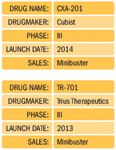
Existing foils for the superbug include Cubist's Cubicin (daptomycin), a drug Cubist cannily licensed to Teva, in exchange for the resolution of a patent dispute; Cubicin will now resist generic challengers through June of 2017. Revenues will help support late-stage candidates like CXA-201, a Phase III drug acquired through Cubist's buyout of Calixa Therapeutics in 2009. CXA-201 is being tested for complicated urinary tract infections (cUTI), and as a first-line intravenous therapy for gram-negative bacterial infections, including multi-drug resistant pseudomonas aeruginosa. For cUTI, the company made the gutsy decision to test against levofloxacin, or generic Levaquin, as a comparator. Levaquin had blockbuster sales in 2010, but lost patent protection this year. "Cubist is banking very heavily on CXA-201," says Selvaraju.
Another class of antibiotics getting lots of attention is the oxazolidinones, of which Pfizer's Zyvox is a member. Despite some overzealous selling techniques—Pfizer acknowledged "certain improper actions" related to Zyvox promotion as part of the company's humongous $2.3 billion settlement over off-label Bextra marketing in 2009—the drug had blockbuster sales in 2010. Trius Therapeutics, a San Diego-based biopharma, is now in Phase III testing on a next-in-class oxazolidinone called tedizolid phosphate, or TR-701. If approved, Bayer will sell the drug outside the US. "Data [on TR-701] is coming in early 2012, and I'm very confident that it will be positive," says Selvaraju. "There's activity in this drug not only in skin infections, but also in bacterially associated pneumonia, so it's got a broad spectrum of activity, and I think it will become a very nice commercial opportunity for Trius going forward."
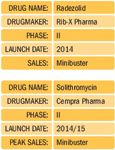
A third member of the oxazolidinones class is Rib-X's Radezolid, which is a little bit further behind TR-701, with Phase III data scheduled for early 2013. Rib-X formed a collaboration with Sanofi to explore bacterial ribosomes as a weapon against superbugs; Selvaraju says Rib-X has a "very unique discovery platform" based on in-depth knowledge of the bacterial ribosome.
Lastly, Cempra Pharmaceuticals is in Phase III with a next-gen oral and intravenous fluoroketolide called solithromycin, a member of the macrolides class of drugs. Macrolides include some of the most widely used agents for treating pneumonia and skin infection, such as Pfizer's Zithromax. Many of the macrolides have gone generic, and solithromycin "appears to have none of the side effect issues [of other macrolides], but does have a much greater activity against resistant organisms than any other member of its class," says Selvaraju.
Diabetes: Added Value
While some believe that FDA has been "overly judicious on compounds for diabetes and other metabolic syndromes," as Matthew Geller, president and founder of Geller Biopharm tells it, there is still a lot going on. After all, the global diabetes market is the fourth-largest, at $34.4 billion in 2010, a 12 percent increase over 2009, according to IMS data. The next possible blockbuster to enter the market may be a GLP-1 from Amylin/Alkermes called Bydureon. The drug worried investors last March after a study showed an efficacy rate slightly below Novo Nordisk's Victoza, a GLP-1 that launched in 2010; although the differentiating factor is Bydureon's once-a-week dosage, compared with Victoza once-a-day and Amylin's Byetta twice-a-day. "People will always prefer the less frequent dosing," says Ben Weintraub. "The reason we like the GLP-1 mechanism of action is that, in addition to glucose control, it helps patients lose weight, and has other ancillary benefits, like bringing down LDL levels and blood pressure."

Lilly backed out of its partnership on Bydureon, after months of bickering (and a lawsuit from Amylin) over Lilly's surprise collaboration with Boehringer Ingelheim to promote other type 2 diabetes drugs, including Tradjenta, an oral DDP-4 inhibitor. Amylin said Tradjenta is a direct competitor of Bydureon, which would create obvious promotional problems. The eventual breakup could be positive for Amylin, according to at least one analyst—Thomas Russo at Robert W. Baird & Co., who upgraded Amylin shares from neutral to outperform post-breakup. Russo told Bloomberg[ital.] that he expects Bydureon to gain approval in January 2012 (the PDUFA date is January 28, 2012), and that Amylin had become an acquisition target after the lawsuit emerged; now the company is free to make a deal. Bydureon was approved in the EU in June.
Novo Nordisk, the insulin Hercules, may receive an FDA approval for its insulin degludec product next year as well; the company submitted an NDA for Degludec and DegludecPlus (ultra-long-acting basil insulin plus a bolis boost of insulin apart) to FDA and EMA in September, and is subsequently in preregistration for both types of diabetes. Degludec is a thrice-weekly formulation, or once every 40 hours. Mads Krogsgaard Thomsen, executive vice president and chief science officer at Novo Nordisk, said on a Q2 earnings call that the company will "seek label flexibility for any time of day, enhancing convenience and potentially treatment compliance." Thomsen told Dow Jones that he expects both to be blockbusters. Meekings was slightly less convinced: "Obviously, there's some benefit [with the dosage], but realistically, I think it will probably be used as a once-daily regimen—prescribers are likely to be wary of weekend dips in glycemic control. That doesn't really differentiate it that much from what's already out there ... It will definitely be a great drug, but how great is the question?" Thomson Reuters forecasts sales of Degludec at $1.5 billion by 2016. On the other hand, "How much more [are patients] willing to pay for ultra-long-acting insulin? ... In a few years we'll have biosimilar insulin, and that will make it even more difficult for new formulations like Degludec to actually get taken up," says Weintraub. "We have pretty modest expectations."

Coming in around the same time as Bydureon is the first of a new—and long-anticipated—class of anti-diabetic drugs, known as sodium-glucose co-transporter 2 protein inhibitors. At the Cleveland Clinic Innovations Summit in October, SGLT2s were named one of the top 10 medical innovations for 2012. The SGLT2s represent "a paradigm shift in diabetes treatment, because they reduce blood sugar in a totally new way: by causing it to be excreted during urination," the Cleveland Clinic said in a writeup of the class. The SGLT2s could also contribute to weight loss, since "so many calories would now be lost during urination."
The closest SGLT2 to market—Bristol-Myers Squibb's and AstraZeneca's dapagliflozin—could be approved as early as the first quarter of 2012, despite the fact that safety concerns, including a small but significant incidence of bladder and breast cancer, gave the FDA pause in late October. Dapagliflozin now shares a PDUFA date with Bydureon, on January 28, 2012. AZ and BMS are in Phase III with a fixed combination of dapagliflozin and metformin for type 2 diabetes. Although the drug is expected to emerge as a post-metformin treatment, the combination "might have huge sales potential if it shows efficacy" in the combo, says Meekings. Thompson Reuters predicts relatively modest sales for dapagliflozin - $403 million in 2016—while Adis R&D Insight has the drug reaching blockbuster status by 2015.
The other SGLT2, originated by Mitsubishi Tanabe Pharma and Tanabe Seiyaku, and licensed worldwide by Johnson & Johnson, is currently in Phase III. The drug is called canagliflozin, and it's also being tested in combination with metformin. J&J has said it expects to file for type 2 "between 2011 and 2015." Adis R&D Insight is less bullish on canagliflozin, with a prediction of $421 million in sales by 2015. The firm doesn't show any revenue for canagliflozin before 2014. We'll find out next year if more, or "ultra" dosages can add enough value to bring in patients and payers.
Rheumatoid Arthritis: Will Pfizer Challenge the Big Three?
Coming out of the November American College of Rheumatology meeting in Chicago, Weintraub says Pfizer's data on its oral Janus kinase (JAK) inhibitor, toficitinib, generated "a ton of excitement ... it will be quite competitive with the TNF inhibitors, which are already a successful class." Pfizer knows about the success of the TNF inhibitors; it licensed Enbrel from Amgen, and co-promotes the drug, one of the big three in rheumatoid arthritis (RA). The others are Humira and Remicade, and together they earned $9.5 billion in 2010, according to IMS data. Humira and Remicade patents will remain strong until at least 2018, and Amgen, through a protracted maneuver at the US Patent and Trademark Office, was recently able to get a new patent on Enbrel, protecting it from generic competition until 2028.
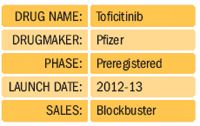
However, all three TNF inhibitors are administered by either injection or infusion, so patients would doubtlessly prefer an oral option, assuming efficacy and side effects measure up. But do they? It appears so. Halfway through Pfizer's 12-month ORAL Standard study, ACR20 rates—a measure that requires a patient to have a 20 percent reduction in the number of swollen and tender joints, and a reduction of 20 percent in three of five categories dealing with physician assessment of disease activity and pain, degree of disability, and protein or erythrocyte sedimentation rate in the blood—were slightly better than data from patients on Humira, although serious adverse events were more common with tofacitinib. Two cardiovascular deaths occurred during tofacitinib testing, but Saeed Fatenejad, Pfizer's head of Inflammation medicines development group, told investors on Nov. 7 that Pfizer "has not seen a signal of increased high blood pressure with tofacitinib."
"People are very positive on tofacitinib," says Selvaraju. "If you're obviating the need for patients to get jabbed with a needle, or go to the hospital to endure a very unpleasant infusion, and you're enabling them to pop a pill instead, that's a big deal." Tofacitinib will "probably come onto the market in late 2012 or early 2013, if all goes well," says Selvaraju. Whether it will challenge the TNF inhibitors right out of the gate, or hang back as a second- or third-line treatment at first, will depend in large part on the label FDA grants Pfizer. Adis R&D Insight predicts blockbuster sales by 2015.
Multiple Sclerosis: BG-12! BG-12!
It's difficult to dig up something negative to say about Biogen Idec's BG-12, an oral MS drug expected to finally hit the market as soon as next year. Huge clinical trials, the most recent of which (aptly named clinical trial DEFINE) found that 240 milligrams of BG-12, taken twice or three times a day, reduced the proportion of patients who relapsed by 49 percent and 50 percent, respectively, at two years compared with a placebo. The problem with other oral agents, such as Novartis' Gilenya—the first-to-market oral MS drug—is that the efficacy-to-side-effect profile isn't nearly as favorable, according to Selvaraju. "The side effect profile [for BG-12] is virtually innocuous ... you've only got GI symptoms, and maybe some nasopharyngitis. In the case of Gilenya, you have a lot of side effects, which have basically precluded its use in early stage, relatively mild cases of MS ... In Europe, it's only prescribed to people who have failed a prior therapy." Selvaraju says Gilenya's "supposed" side effects, including slowed heart rate, compromised lung function, increased incidence of opportunistic infection, etc., have been overstated, and that usage will gradually increase. But with BG-12, "the efficacy is so good that you would even see it take market share away from Gilenya," and for early-stage patients, "it's a dream come true," says Selvaraju.

Biogen Idec expects to file BG-12 at the beginning of next year, or possibly even this year, according to Selvaraju. "I would expect it to be on the market well before the end of 2012," he says. "When that happens, Teva will take a big hit, because would-be Copaxone patients are going to get BG-12 first." A survey of neurologists conducted by Decision Resources found that a whopping 73 percent "indicate that they would prescribe [BG-12] for the treatment of relapsing-remitting MS ... The findings likely reflect neurologists' positive perception of BG-12's clinical profile, which combines strong efficacy, good tolerability, convenient formulation, unique mechanism of action, and a favorable safety profile to date." That's a lot of positives. Adis R&D Insight has BG-12 earning $500 million next year, and turning blockbuster by 2013. Thomson Reuters forecasts $2.1 billion by 2016. Selvaraju says the MS market will grow from $9 billion or $10 billion now, to $15 or $16 billion by 2015-2016. "It's very lucrative, because only a limited number of players will be allowed in the sandbox, since Phase III clinical trials take three to four years," he says.
Orphan Drugs: Finding a Home with Patients
With some 7,000 known rare diseases out there, the orphan drug model makes a lot of sense for certain companies, with certain infrastructures in place. The big three orphan categories—or the three where drugs and clear investment opportunities exist—are enzyme replacement therapies (ERT), which is the biggest, followed by pulmonary arterial hypertension (PAH), and hereditary angioedema (HAE).

In October, Schwartz of Leerink Swann published an extensive report entitled "Future of Orphan Drugs: The Golden Child of Biotech." He discussed two of his favorites with Pharm Exec.
The first is a Biomarin ERT therapy for Morquio A syndrome (MPS IVa), an inherited disease caused by a deficiency of the lysosomal enzyme, N-acetylgalactosamine-6 sulfatase, or GALNS. MPS IVa symptoms include skeletal dysplasia, short stature, and joint abnormalities, which limit mobility and endurance. The disease often leads to shortened life expectancies, and is estimated to occur in 1 in 200,000 live births. There isn't currently a treatment for MPS IVa, but GALNS would supply the lacking enzyme, via transfusion.
Unlike Biomarin's ERT therapy Naglazyme, for the related Maroteaux-Lamy syndrome (both are mucopolysaccharidosis diseases), GALNS won't have to compete with bone marrow transplant, because it hasn't been shown to be helpful for MPS IVa, so Biomarin would have the only treatment. Biomarin's drugs are "basically annuities that grow ad infinitum, because there are always new patients being born with this disease, and there's going to be no change to the pricing and reimbursement model," says Schwartz. "The patients are on it for life." One of the benefits of ERT therapies is that they are "some of the most highly glycosylated products, with a lot of post-translational modifications that make it really difficult for biosimilars to replicate to FDA's satisfaction," he notes. Schwartz likes Biomarin because the company "should get exponential operating leverage on their model, because they'll go to essentially the same geneticists who treat MPS I, VI, IV and Pompe patients ... they don't necessarily need more sales reps." Schwartz says the GALNS ERT could be a blockbuster eventually; Biomarin is expected to announce Phase III data in late 2012. If that seems far-out, consider the fact that orphans "tend to advance more rapidly than a mass-market drug." Leerink Swann forecasts global sales of around $550 million in 2022, and Schwartz describes it as a "miniblockbuster," adding, "you don't need a blockbuster to move the needle on one of these orphan models ... but you could string a few [orphans] together and have a good portfolio."
United Therapeutics Corp. (UTC) is another of Schwartz's favorites, particularly the company's PAH treatment, an oral form of Remodulin (treprostinil). The company already markets an injectable form of Remodulin, and an inhaled form, called Tyvaso. For the treatment of PAH, "it has been a two-company duopoly forever," with UTC's Remodulin and Tyvaso on one side, and Actelion's Tracleer on the other. Gilead has made inroads against Tracleer with Letairis (ambrisentan), a once-a-day oral tablet. Schwartz says Gilead's drug won't impact oral Remodulin, because treprostinil is a protocycline, and protocyclines have a "lot of beneficial effects on certain cell types and PAH, and they're vasodilatory"—meaning they have anti-platelet properties—"but they are very hard to administer." UTC will file with FDA in the first quarter of 2012, says Schwartz, adding that oral Remodulan (aka UT-15C) "has been termed the holy grail by some pulmonologists, that would like to see more of their patients on protocycline therapy, which is considered by some to be the optimal drug for PAH."
UTC's oral Remodulan has produced mixed data to date, and the stock is hovering at near-lows, but Schwartz is unmoved. "These were the same concerns before the inhaled form [Tyvaso] was approved, and it's selling like hotcakes." Schwartz projects a modest $250 million way out in 2025, but says that these drugs "generally outsell their data."
Alzheimer's Disease: Still Waiting
Even the Republican presidential candidates are talking about a cure for Alzheimer's disease, but like most everyone else, they're just diagnosing the problem. Newt Gingrich and Jon Huntsman think NIH should spend more than $450 million a year on Alzheimer's research. Mitt Romney says funding should be determined by mortality rates. Rick Perry sees promise in stem cells for Alzheimer's, and Michelle Bachmann declared on her healthcare website that "as President, I will work to unleash the power of medical innovation ... because a cure is always better and cheaper than care."
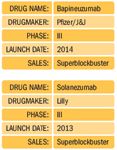
Still, no disease-modifying treatments, or any decent treatments at all, have emerged for the roughly 26 million people affected by Alzheimer's disease globally. Later-stage clinical trials are long and arduous, and are carefully regulated, although a group of industry experts and researchers were able to convince FDA to loosen up on some the of rules last July. After Pfizer and Johnson & Johnson's bapineuzumab caused brain swelling in some trial patients, FDA initially issued stricter guidelines, but has since relaxed them, in recognition of the need for a drug. J&J launched a program called "Healthy Minds" in November, a collaborative affair with $3 billion in seed money, in the hope of combating Alzheimer's through better communication and data networking. The program is a supplement to the International Mental Health Research Organization's "One Mind for Research" program. Lilly's solanezumab, a drug that also targets amyloids, is expected to conclude two identical 18-month, 1,000-patient (with mild to moderate Alzheimer's) trials, called Expedition and Expedition-2, in the first half of 2012.
"Alzheimer's disease, like Parkinson's, is a tough nut to crack," says Geller, but companies have a wide-open market that's ripe for the taking. Alzheimer's is "high risk, high reward," says Weintraub, "but if it does work, it's going to be huge."
iRNA: Curbing Rogue Cells
Small interfering RNA (iRNA), deployed as a therapeutic, could potentially cure cancer. That's a long shot, sure, but it's not inconceivable. So far, no iRNA therapy has progressed past Phase II of development, but some interesting data has been floating around certain corners of the industry, and the Web, as of late.
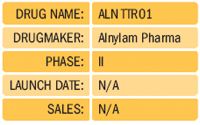
At a November conference in Japan, Alnylam Pharmaceuticals, a leader in the category (with two iRNA treatments in Phase II), announced positive preliminary results from a Phase I trial on ALN TTRO1, an iRNA therapeutic targeting transthyretin (TTR) for the treatment of TTR-mediated amyloidosis, a protein buildup in tissues. All five patients tested responded to the treatment; the group showed lowering of serum TTR protein that ranged from 25 percent to 81 percent (a statistically significant mean of 41 percent) after a single dose, and there were no side effects, beyond minor infusion reactions (13 percent of patients). What does all this mean? For the first time, an iRNA treatment has silenced a disease-causing gene in a clinical trial.
D'vorah Graeser, CEO of Graeser Associates International, a healthcare IP firm, explains iRNA therapies as blockers; they are developed synthetically, and then sent into the body to connect to messenger RNAs (or mRNAs) in cells that have gone rogue. Adjusting the mRNA tones down the protein that's being expressed. "Many times one particular part of the cell's process has gone haywire in cancer, and if you can block one protein from being expressed, then you can hopefully cure cancer," says Graeser. Interfering RNAs are extremely targeted, and could be applicable to whole categories of cancer that have a common mechanism. "Instead of treating cancer according to where in the body it originated, it could be treated by targeting the general mechanism, which has been identified for that particular cancer type," says Graeser.

Alnylam holds patents on delivery mechanisms, which range from particle injections and iRNA coated with liposomes that have a hydrophobic end, like a little cell, to conjugates, or other molecules chemically linked to small iRNA, which help it survive in the body and enter the cell. "For cancer, you'd need something that can survive systemically, and that is a problem," says Graeser. Nevertheless, Alnylam has an iRNA therapy in Phase I for liver cancer, and the company is looking for a partner for Phase II. The company has formed alliances with Roche and Takeda, and has licensing deals with Novartis, Cubist, Biogen Idec and others. Alnylam announced its 5x15 program in January, which "establishes a path for development and commercialization of novel iRNA therapeutics to address genetically defined diseases with high unmet need." The company expects to have five iRNA therapeutic programs in advanced clinical development by 2015.

The Misinformation Maze: Navigating Public Health in the Digital Age
March 11th 2025Jennifer Butler, chief commercial officer of Pleio, discusses misinformation's threat to public health, where patients are turning for trustworthy health information, the industry's pivot to peer-to-patient strategies to educate patients, and more.
Navigating Distrust: Pharma in the Age of Social Media
February 18th 2025Ian Baer, Founder and CEO of Sooth, discusses how the growing distrust in social media will impact industry marketing strategies and the relationships between pharmaceutical companies and the patients they aim to serve. He also explains dark social, how to combat misinformation, closing the trust gap, and more.
Applying Porter’s Five Forces to Portfolio Management in Pharmaceutical R&D: A Strategic Roadmap
March 17th 2025The increasing costs and complexity of R&D in the pharmaceutical industry have necessitated the adoption of strategic portfolio management to optimize resource allocation and enhance competitive advantage.


















